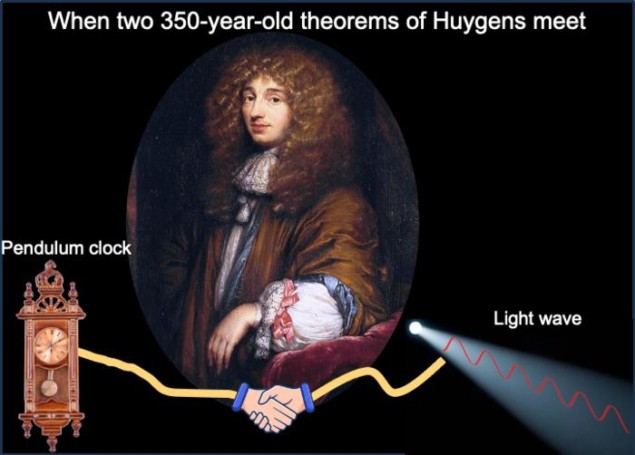
Physicists at Stevens Institute of Technology in New Jersey, US have found a new and surprising link between the wave properties of light and the mechanical properties of point masses. Their finding bridges the gap between classical mechanics and the optics of coherent waves via theories put forward 350 years ago by the Dutch mathematical physicist Christiaan Huygens.
Huygens’s biggest discoveries came in the two most prominent fields of 17th-century physics: optics and mechanics. Among other advances, he was the first to propose (in the 1670s) a wave description of light that accounts for optical propagation as well as important phenomena such as interference, diffraction and polarization that were observed later. He also worked on the mechanical concepts of centre of mass and moment of inertia, which are the two fundamental properties that describe how rigid bodies move.
Xiao-Feng Qian and Misagh Izadi of the Stevens Institute of Technology’s Center for Quantum Science and Engineering and the Department of Physics have now discovered a hitherto unexpected connection between these different parts of Huygens’ work. They did this by analysing two optical coherence properties: polarization, or the direction in which waves oscillate, and entanglement, which in a non-quantum context can be thought of as a unique form of wave correlation. They showed that these two properties are quantitatively related to centre of mass and moment of inertia through the so-called Huygens-Steiner theorem for rigid body rotation.
Parallel axes
Also known as the parallel axis theorem, the Huygens-Steiner theorem states that in a rigid body, the moment of inertia around any axis is always greater than or equal to the moment of inertia around a parallel axis passing through the centre of mass. It also states that the difference between these two moments of inertia is directly proportional to the perpendicular distance between the two axes.
In their study, which is described in Physical Review Research, Qian and Izadi used a geometric mapping procedure to convert light wave intensities into mechanical point masses. By interpreting the intensity of a light wave as the equivalent of a physical object’s mass, they were able to map these intensities onto a coordinate system that could be interpreted using the Huygens-Steiner mechanical theorem.
â€Å�The Huygens-Steiner theorem establishes a quantitative relationship between moments of inertia and the distance between the parallel axes,†Qian explains. â€Å�We have established a quantitative connection of the axes’ distance with optical concepts of entanglement and polarization coherence. The theorem thus serves as a bridge to connect moments of inertia to optical entanglement and polarization.â€Â
A surprising connection
That such a connection should exist is surprising, Qian adds: â€Å�A wave is a physical system that spreads out (it doesn’t have a specified location) and a particle (which can be considered as a rigid object) can be localized at a point. Wave optics and particle mechanics are two completely different physics phenomena so the quantitative relation we have established is unexpected.â€Â
Although the connection hadn’t been shown before, it becomes very clear once you map the properties of light onto a mechanical system, he says. â€Å�What was once abstract becomes concrete: using mechanical equations, you can literally measure the distance between centre of mass and other mechanical points to show how different properties of light relate to one another.â€Â
While the work is theoretical, Qian and Izadi expect that the quantitative relation they discovered could help develop procedures in which mechanical masses could simulate the behaviour of light wave entanglement. �Measuring entanglement (and polarization) typically requires complex and costly techniques,†Qian explains. �Simulating them by measuring the mechanical centre of mass and moment of inertia will be much easier and economical.

The secret of the synchronized pendulums
â€Å�We’ve known for over a century that light sometimes behaves like a wave, and sometimes like a particle, but reconciling those two frameworks has proven extremely difficult,†he adds. â€Å�Our work doesn’t solve that problem – but it does show that there are profound connections between wave and particle concepts not just at the quantum level, but at the level of classical light-waves and point-mass systems.â€Â
The Stevens team is now investigating the quantitative connections between quantum entanglement and classical mechanical point mass systems. �We have already obtained some key results and expect some further unexpected results in the future,†Qian tells Physics World.
They report their present work in Physical Review Research.

